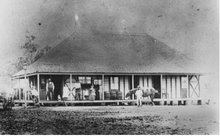Nowadays, there is a lot of mystique surrounding the making of bread. Perhaps it is because bread making has diverged in two directions. The first is the commercial mass production route where bread is made as quickly as possible and additives used to increase its shelf life and ease of transportation. The other direction in which bread making has gone has been that of the artisan fanatic. This fan might start by grinding their own flour, mixing it with a secret sourdough starter, taking the time required to make the perfect hand-made loaf. Having said there are two directions, of course there are other options within this range. Some people love the ease of the bread maker, which parallels commercial bread making – using a kit, aiming for speed, but making fresh bread at home. There are artisanal shops producing careful loaves, but this is the domain of the metropolis and the affluent. And there are speciality bakers, making semi-artisanal loaves in an adaptation of mass production.
Bread-making in the nineteenth century would not have been so complicated. It was Germany, so Michael and Anders would have made rye bread, as well as an everyday loaf. If you are making bread day in and day out, then it is hard to isolate the individual processes. It is more of a continuous cycle of changes to the flour and yeast.
The Jaeckels bought flour from a miller on the outskirts of Marburg. They had a well-ventilated storeroom at the back of the shop acroos a small courtyard but only held about a week’s supply in there. The bakery was simply laid out. The back of the main room was filled by the brick oven in which a fire always burnt. Reliable daily baking required that the heat be maintained in the mass of the stove, with only a small intense firing to raise the temperature in the baking cavity immediately before the loaves were put in. And the loaves needed the steady warmth for rising.
Customers wanted their bread fresh first thing in the morning. After the morning rush of customers, Michael would mix their starter that they kept in the coolness of the well with fresh flour and yeast. Initial mixing was done in troughs under the shade of an awning in the courtyard because the dough needed to be kept cool until they were ready to make the bread. After making this first batch of dough, the men went to bed for a quick nap then were up to complete the rest of their day.
Michael and Anders were in bed by five o’clock after an early meal so that they could get up at one in the morning to start the bread. The cool first batch of dough would be mixed with fresh flour, yeast, salt and water. This time the mixing was done in the warm workroom in the shop. After working the bread in huge troughs with long wooden paddles, the dough was left to rest for an hour. The dough was briefly worked again, and rested for another hour then after turning, another half hour rest. The dough was then turned out onto a long bench, cut and weighed, shaped into balls and placed into baskets lined with floured linen. Almost two hours later, the loaves were tipped onto a wooden peel, slashed and baked in the oven until dark brown. Some of the uncooked dough was kept back to start the next batch of bread. Family bakeries had starters that had been continuously in use for years.
This was sturdy, chewy bread that was produced. For festivals and other occasions, the bread was formed into different shapes, perhaps braids or coronets, but the everyday loaf was circular, solid and dark brown.
Making bread was hard physical work in difficult conditions. Michael was a solid bulk of a man and Anders was quickly developing similar broad shoulders and chest. Seeing customers was their main social contact as they kept very different hours to most of the townspeople. They were friendly, but too busy to be involved in too many things. Their family was their mainstay and their primary social group.
Subscribe to:
Post Comments (Atom)

No comments:
Post a Comment